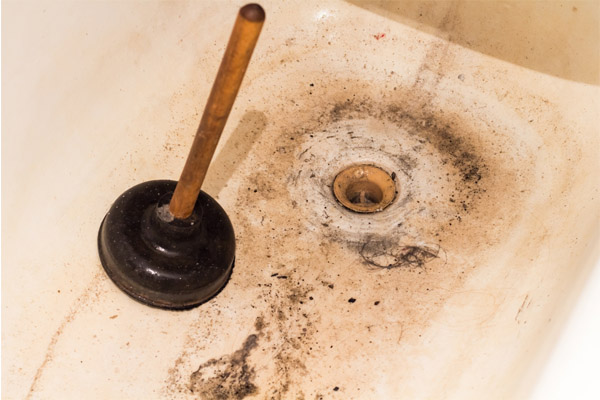An Guide to Waste Emergence in the Bathtub
An Guide to Waste Emergence in the Bathtub
Blog Article
What are your opinions concerning Why sewage is coming up through your bathtub?

Sewer backup in the bath tub can be a distressing and unhygienic issue for any kind of homeowner. Not just is it inconvenient, but it additionally presents serious health dangers and suggests underlying concerns with the plumbing system. Recognizing why sewage is turning up via the bathtub is vital for taking appropriate action to resolve the problem effectively.
Intro to the Issue
Common Factors for Sewer Backup
Obstructions in the Sewage System Line
One of one of the most common sources of sewer back-up is a clog in the sewage system line. This can take place due to the build-up of particles, grease, or international items in the pipelines, protecting against correct circulation and triggering sewer to back up right into your tub.
Tree Origin Breach
Tree origins looking for wetness and nutrients can penetrate sewage system lines with tiny splits or joints. With time, these roots can grow and expand, creating considerable damage to the pipes and leading to sewer backup issues.
Comprehending the Problem
When sewer draws back up into the bathtub, it's a clear indication of an issue with the drainage system. The wastewater that must be flowing away from your home is instead finding its way back right into your home, which can bring about significant damages and carcinogen.
Possible Causes
A number of variables can add to sewer backup in the bathtub. From blockages in the sewer line to concerns with the plumbing framework, determining the source is crucial for finding a service.
Aging Infrastructure
Older homes may have obsoleted plumbing systems that are a lot more prone to corrosion, splits, and degeneration. As pipelines age, they become extra susceptible to leaks and blockages, increasing the possibility of sewer back-up occurrences.
Heavy Rainfall or Flooding
Throughout periods of heavy rainfall or flooding, the sewer system may end up being overwhelmed with excess water, triggering back-ups and overflows. This can result in sewer backing up into bathtubs and various other components inside the home.
Signs of Sewer Backup
Foul Odors
Unpleasant smells originating from drains or components, specifically in the bathroom, might indicate sewer back-up problems. These smells are often strong and persistent, signifying a problem that requires prompt focus.
Slow Draining Fixtures
Bathtubs, sinks, and toilets that drain slowly or otherwise whatsoever could be experiencing sewage backup. If multiple components are impacted simultaneously, it's most likely that the problem stems from an usual factor, such as the primary drain line.
Gurgling Noises
Unusual gurgling or gurgling noises originating from drains pipes when water is running somewhere else in your home are indicative of air trapped in the plumbing system. This air build-up can result from sewage backup and must be examined immediately.
Health Threats Connected With Sewage Backup
Contamination of Water Supply
Sewer back-up can pollute the supply of water in your house, positioning a significant health threat to you and your family. Exposure to contaminated water can bring about stomach problems, skin infections, and various other illnesses.
Mold Growth
Moisture from sewage back-up can produce excellent problems for mold development in your house. Mold spores can exacerbate respiratory issues and create allergies in sensitive individuals, making punctual cleanup crucial.
Spread of Illness
Sewage consists of harmful microorganisms, infections, and parasites that can trigger a variety of illness, consisting of hepatitis, cholera, and gastroenteritis. Entering contact with sewer or contaminated surfaces places you in danger of infection.
Cleaning Up After Sewage Backup
Disinfection Procedures
Completely disinfect and sterilize affected areas after sewage backup to eliminate damaging microorganisms and stop mold growth. Usage suitable cleaning products and protective equipment to make sure risk-free and efficient clean-up.
Reconstruction of Influenced Areas
Repair any damages to flooring, walls, or fixtures brought on by sewage back-up. Depending on the level of the damage, you may require to change carpets, drywall, or various other materials to restore your home to its pre-loss condition.
Immediate Actions to Take
Switching Off Water Supply
In the event of sewage back-up, it's important to turn off the water system to prevent further contamination and damages. Situate the major water shutoff valve in your home and closed it off till the concern can be resolved.
Speaking To a Professional Plumber
Dealing with sewage back-up is not a do it yourself task. Call a certified plumber with experience in handling sewage-related problems to examine the situation and do needed repairs or cleanups.
Avoiding Contact with Infected Water
Until the sewer backup is resolved, stay clear of contact with infected water to prevent the spread of bacteria and microorganisms. Wear safety equipment if you need to remain in the afflicted location and clean your hands thoroughly afterward.
Safety nets
Normal Maintenance of Drain Lines
Arrange normal evaluations and upkeep of your drain lines to recognize and resolve potential problems before they intensify into major troubles. This can include cleaning debris, inspecting for tree root breach, and fixing any kind of broken pipes.
Mounting Backwater Valves
Think about setting up bayou shutoffs in your plumbing system to prevent sewage from flowing back into your home throughout durations of heavy rainfall or flooding. These valves immediately close when water starts backing up, safeguarding your home from contamination.
Correct Disposal of Home Waste
Prevent purging anything besides toilet tissue and human waste down the commode to stop obstructions and clogs in the drain line. Dispose of oil, oil, and various other house chemicals correctly to lessen the threat of plumbing problems.
Why Is Water Backing Up in My Bathtub When I Flush My Toilet?
What to do about a sewer line clog
First, don’t bother with plunging. No amount of plunging will dislodge the clog in a sewer line. The clog is too far away. Plungers are for clogs in the toilet itself, not the sewer line. Plus, the most likely causes of a sewer clog are:
Tree roots Flushed toys or feminine products Grease buildup Those items don’t move easily. And in the case of tree roots, the roots need to be cut out of the pipe and the pipe will need to be repaired.
You’ll need a closet auger. A closet auger is a type of plumber’s snake with a protective cover to keep from scratching the delicate porcelain toilet. If the clog is further down, you may need to remove the toilet or use one of your cleanouts to get to the clog.
We also recommend doing a video inspection of the drain to ensure that the cause of the clog has been completely removed. Otherwise, you could have the same problem again in a few days or weeks.
https://mspplumbingheatingair.com/blog/why-is-water-backing-up-in-my-bathtub-when-i-flush-my-toilet

I came across that blog posting about Water Coming up Bathtub Drain when browsing on the internet. Sharing is nice. You never know, you might be helping someone out. We cherish reading our article about .
Source This Article
Report this page